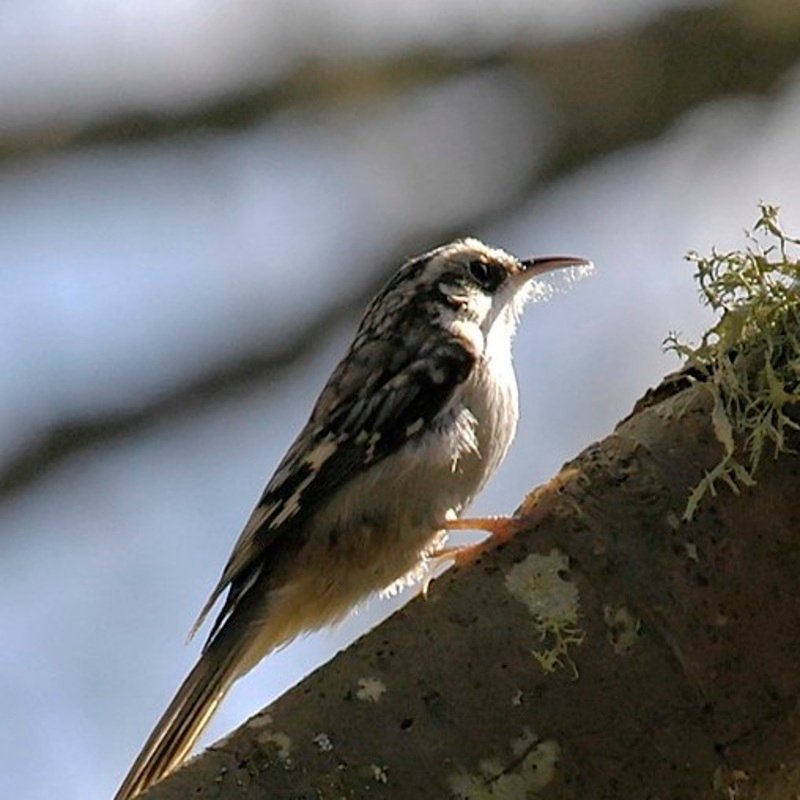Certhia americana, commonly known as the American treecreeper, is a tiny songbird native to North America and the sole member of the treecreeper family Certhiidae. It is the only member of the treecreeper family to be found in North America.
Quick Overview: Certhia Americana – Brown Creeper
Body size: Around 5.25 in (13 cm) and a weight of 9 g (0.3 oz)
Main colors: Brown, White, Red-brown
Range: Throughout the United States
Migratory Bird: Yes
Best time of the year to see in the U.S.: January, February, December
Conservation Status: Least Concern
Brown creeper Description
Brown creepers are small birds with mottled feathers that, when observed from a distance, are virtually indistinguishable from a piece of bark. These birds have dark-brown upper parts that are extensively streaked with white on the head, back, and scapulars (feathers that cover the shoulder) as well as on the wings. Its eyes are distinguished by a brown stripe running across them and a white stripe above them. The underparts are white with a hint of red/brown flecked throughout. This species is distinguished by the presence of a long, stiff tail covered with feathers that serve as a prop to assist the birds in moving up and around the trunk of a tree.

Size
These birds have a length of 5.25 in (13 cm) and a weight of 9 g ( 0.3oz). Their wings could range from 7-8 in (18-20 cm).
Feeding
Brown creepers prey mostly on tiny arthropods such as spiders, pseudoscorpions, and insects, although they will sometimes consume larger insects. Stinkbugs, fruit flies, and weevils are just a few of the insects that they are known to prey on. During the winter, brown creepers consume seeds and other vegetative materials, as well as dead insects.
Habitat
Brown creepers may be found in coniferous forests and mixed coniferous-deciduous forests, among other environments. They require huge trees (dead or living) for foraging and breeding, and they cannot survive without them. Brown creepers may be found in coniferous forests across the Pacific Northwest, although they prefer to avoid the Olympic Mountains’ woods, where the trees are considerably bigger and more widely spaced. Brown creepers are more common in older red cedars, spruce-fir, and mixed conifer forests in the Rocky Mountains than they are in younger coniferous forests.
Behavior
Brown creepers are typically only able to fly a short distance between tree trunks. They begin feeding at the base of a tree and when they reach the top, they fly to the base of the next tree and begin foraging all over again, and so on. In the winter, they join mixed-species foraging groups.
Certhia americana Scientific Classification
- Kingdom: Animalia
- Phylum: Chordata
- Subphylum: Chelicerata
- Class: Aves
- Order: Passeriformes
- Family: Certhiidae
- Genus: Certhia
- Species: Certhia american
Best time of the year to see
The best time to see these birds in the United States is during the winter season (December to February).
Distribution of the Brown creeper in the USA
North American treecreepers are brown creepers. They are distributed from Canada and Alaska to northern Nicaragua. Brown creepers breed along with Alaska’s and Canada’s coasts. Brown creepers breed in British Columbia along the west coast and in the interior. Only a few investigations have determined the northern range of brown creepers. Brown creepers are found in the Rocky Mountains of western Washington, Oregon, and northern California.
The Brown creeper can also be found in the following states in the United States – Alabama, Alaska, Arizona, Arkansas, Colorado, Connecticut, Delaware, Florida, Georgia, Hawaii, Idaho, Illinois, Indiana, Iowa, Kansas, Kentucky, Louisiana, Maine, Maryland, Massachusetts, Michigan, Minnesota, Mississippi, Missouri, Montana, Nebraska, Nevada, New Hampshire, New Jersey, New Mexico, New York, North Carolina, North Dakota, Ohio, Oklahoma, Pennsylvania, Rhode Island, South Carolina, South Dakota, Tennessee, Texas, Utah, Vermont, Virginia, West Virginia, Wisconsin and Wyoming.
